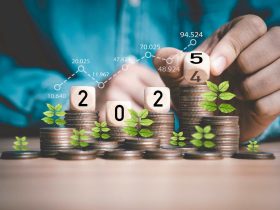Investopedia’s editor discusses the current indecisiveness in the Yahoo Financial interview below. He explains that investors are wavering between two opposing stock market fears: FOMO (the fear of missing out on a bull rise) and FOLA (the fear of losing it all in a bear collapse).
Expect a “classic” resolution to produce a new trend
When stock market fundamentals first hint at a move up or down, an opposite move often takes place first. Why? There are various possible causes. Think of it as setting the stage. A drop before an uptrend brings in seasoned investors, and a runup induces selling by the same group.
(An old saying about this initial move, as I best remember it, is, “When the market can’t go up, it goes down to make room.”)
Feeding the initial move are less-seasoned investors who take it at face value. They help provide the attractive prices as they sell on the drop or buy on the runup.
Note: This discussion may seem to be about some investors taking advantage of others. It’s not. It’s simply the way the market works, with different people’s ideas coming together to set prices. And that means human nature is the driving force.
So, what’s the result going to be? Up or down?
Likely, down after an initial bump up.
There are many negative issues, uncertainties and risks at work. Most will take time to be seen in full and to be worked out. Such lengthy, complex, and weighty developments likely mean there is more downside ahead. The lack of understanding among investors is significant because of those characteristics. Moreover, it is compounded by the misleading Federal Reserve “education” that abnormally low interest rates are beneficial and that the Fed is winning the inflation fight.
Then there is the optimism about where the stock market stands. The performance being reported is for 2023 to date (S&P 500 up 16.1%, Nasdaq up 31.5%). Ignored are the reality anchors: the 2022 selloff (S&P 500 down 19.4% and Nasdaq down 33.1%) and inflation throughout. When 2022 is included, performance results are still negative: S&P 500 down 6.5% and Nasdaq down 12%. Adjusting for inflation (core CPI = 8% for entire period), the “real” performance results are S&P 500 down 13.4% and Nasdaq down 18.5%.
Then, there is an important issue not being discussed: The continued interest in the past favorite stocks and fads, including the expectation that they will be important in the next stock market rise. However, bull markets do not repeat. Instead, the next rising market will be different from the past one – and there are no clear bull visions yet beyond artificial intelligence.
The bottom line: Keep the safe rate in mind when thinking about stocks
In late 1969, as a newly registered stock broker, I met the West Coast regional manager. We talked about the stock market, and then he asked me a key question: “What do you say to an investor who asks, ‘Why should I buy stocks when I can get a safe 6% yield?'” (CPI inflation was also about 6%.)
We were in a 3-year bull stock market, and this valid question undid my presumption that the new decade would be bright. Therefore, I shifted to conservative investing. Doing so paid off through the 1970 bear market and recession. Additionally, I was ready and early for the 1971-1972 “nifty-fifty” growth stock market.
Therefore, it’s time to ask, “Why should I buy stocks when I can get a safe 5% yield?”
Read the full article here













Leave a Reply